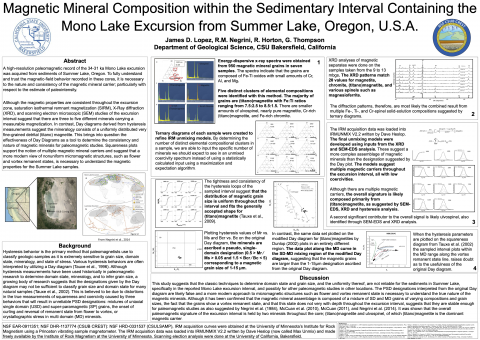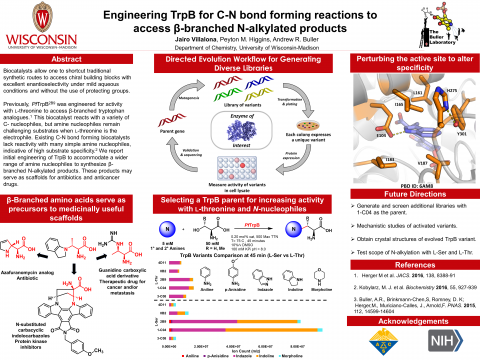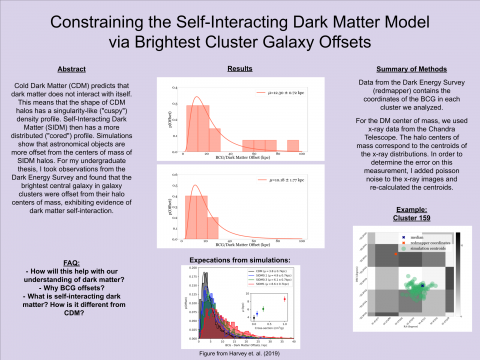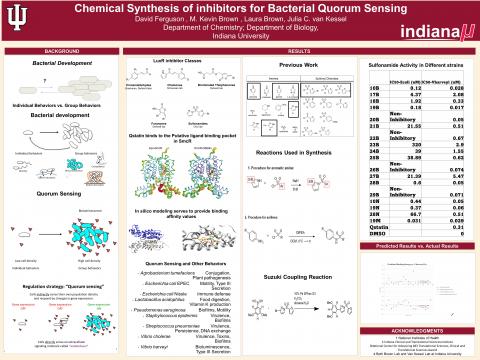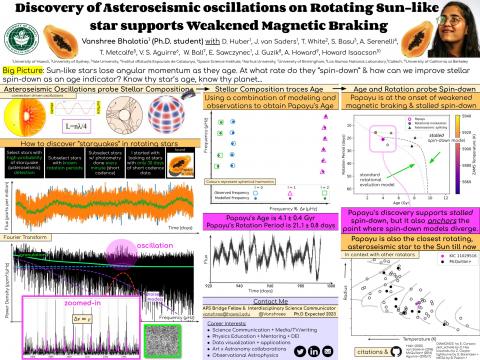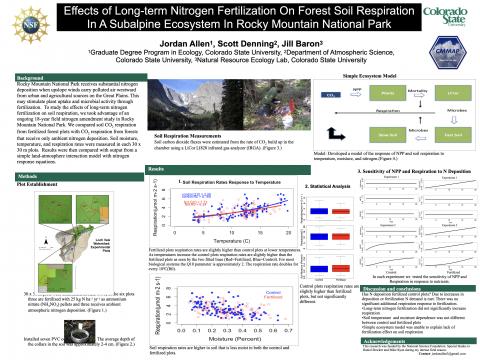2021 IGEN Bridge Fellow Poster Submissions
- [A1] Magnetic Mineral Composition within the Sedimentary Interval Containing the Mono Lake Excursion from Summer Lake, Oregon, U.S.A. Presented by: James D. Lopez
- [A2] Engineering TrpB for C-N bond forming reactions to access ß-branched N-alkylated products. Presented by Jairo Villalona
- [A3] Measuring the CO/CO2 Mixing Ratio in Comets. Presented by Olga Harrington Pinto
- [A4] Engineering TrpB for C-N bond forming reactions to access ß-branched N-alkylated products. Presented by Dane Cross
- [B1] Chemical Synthesis of inhibitors for Bacterial Quorum Sensing. Presented by David Joshua Ferguson
- [B2] Discovery of New Asteroseismic Gyrochronology Benchmark in Kepler Data. Presented by Vanshree Bhalotia
- [B3] Effects of Long-term Nitrogen Fertilization On Forest Soil Respiration In A Sub-alpine Ecosystem In Rocky Mountain National Park. Presented by Jordan Allen
A high-resolution paleomagnetic record of the 34-31 ka Mono Lake excursion was acquired from sediments of Summer Lake, Oregon. To fully understand and trust the magnetic-field behavior recorded in these cores, it is necessary to determine the nature and consistency of the magnetic mineral carrier, particularly with respect to the estimate of paleointensity.
Although the magnetic properties are consistent throughout the excursion zone, saturation isothermal remnant magnetization (SIRM), X-Ray diffraction (XRD), and scanning electron microscopic (SEM) studies of the excursion interval suggest that three to five different minerals are carrying a measurable magnetization. In contrast, Day diagrams derived from hysteresis measurements suggest the mineralogy consists of a uniformly distributed very fine-grained detrital (titano) magnetite. This brings into question the effectiveness of Day Diagrams as a tool to determine the consistency and nature of magnetic minerals for paleomagnetic studies. Squareness plots support the notion of multiple magnetic mineral carriers and suggest that a more modern view of nonuniform micromagnetic structures, such as flower and vortex remanent states, is necessary to understand the magnetic properties for the Summer Lake samples.
Funding Acknowledgement
NSF EAR-0911351; NSF DHR-1137774 (CSUB CREST): NSF HRD-0331537 (CSU LSAMP)
Cross coupling reactions are commonly employed by medicinal chemists to synthesize products containing C-N bonds to access a pharmaceutically rich space. However, these strategies require lengthy routes using numerous protecting groups leading to a poor atom economy. Traditional organic cross-coupling often requires harsh conditions and hazardous reagents or solvents. Biocatalysts, such as TrpS from Pyrococcus furiosus, allow one to bypass multiple synthetic steps to access chiral building blocks with exquisite enantioselectivity under mild aqueous conditions and without the use of protecting groups.
The TrpB subunit of TrpS natively catalyzes the condensation of indole L-serine to form L-tryptophan. Directed evolution was utilized to create a stand-alone TrpB variant, PfTrpB0B2, with activity on a range of indole analogs. Another variant, PfTrpB2B9, was engineered for activity with L-threonine to access β-branched analogues. This biocatalyst reacts with a variety of nucleophiles to catalyze C-C, C-N, and C-S bond forming reactions. Nevertheless, amine nucleophiles remain challenging substrates when L-threonine is the electrophile. Existing C-N bond forming biocatalysts lack the substrate scope to fit most amine nucleophiles due to their substrate specificity. Therefore, we report engineering of TrpB to accommodate a wider range of amine nucleophiles to synthesize β-branched N-alkylated products. These products serve as scaffolds for protein kinase inhibitors, antibiotic analogs such as azafuranomycin, and anticancer drugs.
Funding Acknowledgement
American Chemical Society
CO and CO2 are abundant molecules in comets that play important roles in driving activity, especially beyond ~3 AU where water-ice sublimation is inefficient (Crovisier & Encrenaz 2000, Womack et al. 2017). The CO and CO2 mixing ratio in comets provides important observational constraints to models of solar system formation and evolution and physical models of the nucleus of comets (Mumma & Charnley 2011, Mandt et al. 2015). Comets that are labeled as Oort Cloud (OCCs), Jupiter Family (JFCs), and Centaurs based of where they traveling from rather than where they were born since that is still not well known. Though there is the rising idea that comets may have formed in the same region in the early solar system.
Funding Acknowledgement
No funding acknowledgement submitted.
Dark matter interactions are at the forefront of many areas of physics. In particle physics, models such as supersymmetry predict that dark matter interacts with itself through forces other than gravity. Since dark matter does not interact strongly with luminous matter, the only way to test if dark matter actually interacts with itself is to study its behavior on the scale of gravitational interactions. My research focuses on these large-scale interactions by examining the shape of dark matter halos.
Cold Dark Matter (CDM) predicts that dark matter does not interact with itself. This means that the shape of CDM halos has a singularity-like ("cuspy") density profile. Self-Interacting Dark Matter (SIDM) then has a more distributed ("cored") profile. Simulations show that astronomical objects are more offset from the centers of mass of SIDM halos. For my undergraduate thesis, I took observations from the Dark Energy Survey and found that the brightest central galaxy in galaxy clusters were offset from their halo centers of mass, exhibiting evidence of dark matter self-interaction.
Funding Acknowledgement
No funding acknowledgement submitted
Bacterial communication is cell-density dependent and relies on chemical cues. This communication is called quorum sensing. In this project we develop inhibitors of the sulfonamide variety, to target this communication pathway. The overall goal is to provide an alternative therapeutic strategy to target vibrio(s) ( a type of marine bacteria). Given the fact that vibrio infections are on the rise, this is a niche that is worth working on, and exploring for the benefit of humanity.
Funding Acknowledgement
- National Institutes of Health
- Indiana Clinical and Translational Sciences Institute
- National Center for Advancing Translational Sciences, Clinical and Translational Sciences Award
[B2] Discovery of New Asteroseismic Gyrochronology Benchmark in Kepler Data
Vanshree Bhalotia1, Daniel Huber2, Jennifer L. van Saders2, Tim R. White3, Sarbani Basu4, Aldo M. Serenelli5, Travis S. Metcalfe6, Víctor Silva Aguirre Børsen-Koch7, Warrick H. Ball8, Erica Sawczynec1, Joyce A. Guzik9, Andrew W. Howard10, Howard Isaacson11
1University of Hawai'i at Mānoa, Department of Physics and Astronomy 2University of Hawai'i, 3University of Sydney, 4Yale University, 5Institut d'Estudis Espacials de Catalunya (IEEC), 6Space Science Institute, 7Aarhus University, 8University of Birmingham, 9Los Alamos National Laboratory, 10Caltech, 11University of California at Berkeley
Stellar spin down is a critical yet poorly understood component of stellar evolution. In particular, recent results from the Kepler Mission imply that mature age, solar-type stars have inefficient magnetic braking, resulting in a stalled spin-down rate. However, a large number of precise asteroseismic ages are needed for mature (≥ 3Gyr) stars in order to probe the regime where traditional and stalled spin-down models differ. In this poster, we present a new asteroseismic benchmark star for gyrochronology discovered using reprocessed Kepler short cadence data. KIC 11029516 (Papayu) is a bright (KEP mag = 9.63) solar-type star with well-measured rotation period of 21.1 +/- 0.82 days from spot modulation over 4 years of Kepler long cadence data. We combine asteroseismology and spectroscopy to obtain a Teff of 5888 +/- 100 K, [Fe][H] of 0.30 +/- 0.06 dex, mass of 1.23 +/- 0.05 Msun, radius of 1.34 +/- 0.03 Rsun and age of 4.1 +/- 0.4 Gyr, making Papayu one of the closest stars to the Sun in terms of mass and radius with a well-measured age and rotation period.
We find that Papayu sits at the transition of where traditional and weakened spin-down models diverge, and a comparison with stars of similar zero-age main-sequence temperatures supports previous findings that a weakened spin-down models are required to explain the ages and rotation periods of old solar-type stars in the Kepler field.
Funding Acknowledgement
All the photometric data presented in this poster was obtained from the Mikulski Archive for Space Telescopes (MAST). STScI is operated by the Association of Universities for Research in Astronomy, Inc., under NASA contract NAS5-26555. Support for MAST for non-HST data is provided by the NASA Office of Space Science via grant NNX13AC07G and by other grants and contracts. The spectral data presented herein were obtained at the W. M. Keck Observatory, which is operated as a scientific partnership among the California Institute of Technology, the University of California and the National Aeronautics and Space Administration. The Observatory was made possible by the generous financial support of the W. M. Keck Foundation
Rocky Mountain National Park receives substantial nitrogen deposition when upslope winds carry polluted air westward from urban and agricultural sources on the Great Plains. This may stimulate plant uptake and microbial activity through fertilization. To study the effects of long-term nitrogen fertilization on soil respiration, we took advantage of an ongoing 18-year field nitrogen amendment study in Rocky Mountain National Park. We compared soil CO2 respiration from fertilized forest plots with CO2 respiration from forests that receive only ambient nitrogen deposition. Soil moisture, temperature, and respiration rates were measured in each 30 x 30 m plots. Results were then compared with output from a simple land-atmosphere interaction model with nitrogen response equations.
Funding Acknowledgement
The National Science Foundation

